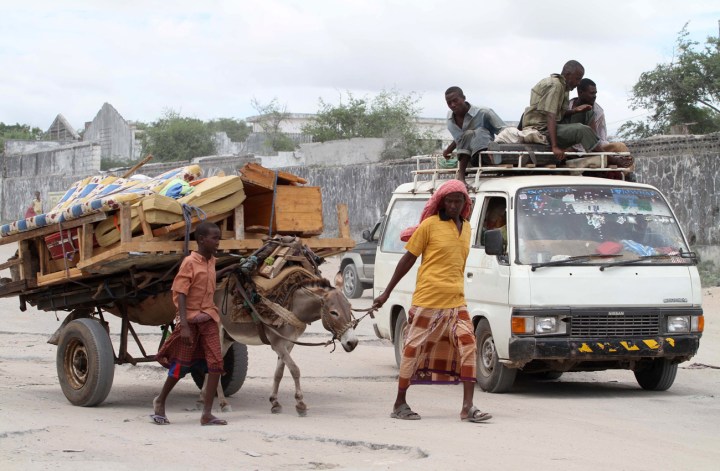Africa, Maverick Life, Media, Politics
Kenya and Somali refugees: A culture of mistrust

Kenya’s incursion into Somalia last October, dubbed Operation Linda Nchi or Protect the Country, signalled a renewed vigour in the war against Al-Shabaab. As part of the operation, officials also launched a crackdown in the North Eastern province of Kenya, intent on weeding out the Somali cell of al-Qaeda sympathisers. In the process, Kenyan Somalis and Somali refugees were arbitrarily arrested and gravely mistreated. By KHADIJA PATEL.
Last November, a Kenyan soldier was killed by an explosive device in the town of Mandera, near the Somali border. In response, the Kenyan police, military and soldiers of the Transitional Federal Government of Somalia, who had crossed into Kenya from Somalia, rushed to Mandera to find those responsible.
As one witness recounts, “There was a blast on Thursday in the middle of town. Immediately the [police] started picking up people around there. Some schoolboys were beaten seriously. Some were in the hospital… I escaped by the skin of my teeth. My neighbours were whipped by the military. They were beaten seriously. I had rushed to the scene to see what was happening, and the military surrounded us… One man was bleeding from the head, and I took him to the hospital. Some of my boys were bleeding. I’m a teacher. These were boys of 12, 13, 15 years – young, small boys. The soldiers were beating people with clubs.”
A new report from Human Rights Watch, Criminal Reprisals: Kenyan Police and Military Abuses against Ethnic Somalis, details significant human rights abuses by the Kenya Defence Forces and police in apparent response to a series of grenade and improvised explosive device (IED) attacks that targeted the security forces and civilians in North Eastern province.
Rather than conducting investigations to identify and apprehend the perpetrators, the police and army appear to have applied little discretion in using force against Kenyan citizens and Somali refugees.
Speaking to Human Rights Watch about their experiences, Somalis allege Kenyan forces arbitrarily detained people, subjecting them to indiscriminate beatings and sexual abuse. In the Dadaab refugee camp, where police carried out a raid on refugees after several explosive attacks resulted in the death of two Administration Police officers, a woman was raped.
Recounting her experience to Human Rights Watch researchers, she said: “It was the day after an explosion in the market… They were three policemen who came. They were saying, ‘Bring us money’ and ‘Where is your husband?’
The three of them started beating me with a metal stick. They lifted me up to [take me] inside the house. I shouted, saying that I was a teacher… Two of them moved out of the house, leaving behind one who immediately started locking the door and opened the zipper [of his trousers] while holding my neck in his right hand. I started screaming and fought back with him. In the process he stripped my underwear off and pulled me towards himself while standing, and as I struggled, after some time, I felt his sperms rolling over my thighs.”
Besides the sizeable Somali refugee population, Kenya also has a substantial indigenous Somali population, concentrated mainly in the North Eastern Province, the least developed region in Kenya. It is bedevilled by a history of insurgency, misrule, repression, chronic poverty, massive youth unemployment, high population growth, insecurity, poor infrastructure and lack of basic services. With political unrest and conflict close by in Somalia, the ethnic Somalis living there have battled to ward off political, social and economic marginalisation. So long as instability in Somalia ripples across the border, bringing guns, grenades and armed gangs, Nairobi has reacted with repression.
In turn, the Somali communities harbour a long-standing suspicion of the Kenyan state and its motives. As Human Rights Watch surmises, the behaviour of the security forces in the North Eastern province has done little to endear Kenyan officials to residents. Instead, it has fed into the culture of mistrust and resentment.
“The result of the repeated beatings and mistreatment of residents of North Eastern province has been a diminishing trust in the Kenyan security forces at the very moment when those forces most need the confidence of the people in order to accomplish their security objectives,” Human Rights Watch says.
The security crackdown in the province between November last year and March has served to further increase the sense of marginalisation of the Kenyan Somali population. “There is a long history of abuse suffered by Somalis at the hands of Kenyan authorities,” Neela Ghoshal, Human Rights Watch East Africa researcher told Daily Maverick. “What this report shows is that, despite the new constitution in Kenya and efforts to implement reform to the police services, not much has changed. They behave with impunity.”
She points out that campaigns of discrimination against Somalis have ebbed and flowed. “In the last 30 years there have been waves of abuses against Somalis. The Kenyan incursion into Somalia last year began a new wave,” Ghoshal said. “People have a long memory. Even young people speak of a massacre of Kenyan Somalis in the 80s, as though they were there.”
Ghoshal points out that, though the province has not witnessed any new attacks since February, Al-Shabaab is still likely to hit back against Kenya for taking the fight to it in southern Somalia. “It may be days, weeks, or months but Al-Shabaab will hit back again with another grenade attack or another explosion,” she said. But in the lull, the Somalis in Kenya have enjoyed a breather – Kenyan security officials have been content to let them be. But Ghoshal is concerned that the next Al-Shabaab attack will not see the security forces behaving any differently.
The Kenyan ministry of state for defence and the ministry of state for internal security are both reported to have promised to investigate the abuses and hold accountable the officers who are responsible. The defence ministry has already formed an ad hoc board of inquiry that has interviewed victims of abuse in Garissa, Mandera and Wajir.
Human Rights Watch, however, is sceptical of a positive outcome, saying: “It is unclear what steps the ministry will take if the reports are confirmed. The internal security ministry has thus far taken no concrete actions to investigate the abuses.”
When Human Rights Watch first alleged abuses against Somalis in the North Eastern province in February this year, a military official was reported to have retorted that the army has nothing against Somalis and Kenyan Somalis. The reprisals against ethnic Somalis, however, have contributed to the culture of mistrust of the security forces by North Eastern province residents, who feel that too often since independence, the Kenyan security forces have abused ethnic Somalis with impunity.
In January this year, the International Crisis Group warned that the Kenyan military incursion into Somalia threatened to incite radicalisation among ethnic Somalis in the North Eastern province. “The Kenyan government must recognise that a blanket or draconian crackdown on Kenyan Somalis, or Kenyan Muslims in general, would radicalise more individuals and add to the threat of domestic terrorism.
“The security forces have increased ethnic profiling but otherwise appear relatively restrained – especially given past behaviour. Still, counter-terrorism operations need to be carefully implemented and monitored, also by neutral observers,” it said.
But for now Ghosal is confident elements of radicalisation remain on the fringe in the region. “The vast majority of people we spoke to don’t support Al-Shabaab. They are angry at the Kenyan government but this anger is not translating into widespread support for Al-Shabaab. Only small elements of the community are sympathetic to Al-Shabaab. Most people would prefer the conflict in Somalia was over. They are vulnerable to Al-Shabaab sympathisers and also the Kenyan security officials,” she said. DM
Read more:
- Read the full Human Rights Watch report here.
Photo: Residents carry their belongings as they flee from their homes in the Afgoye region some 30km (19 miles) from Somalia’s capital Mogadishu, November 14, 2011, following heavy explosions. REUTERS/Feisal Omar.

















 Become an Insider
Become an Insider